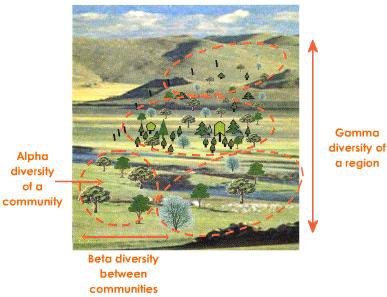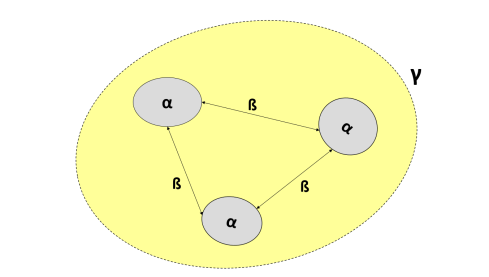Scale is absolutely critical in ecological studies. Everything, and I mean everything, depends on the scale at which it is defined. The is true for species diversity as well. Diversity of species (sometimes communities) in a landscape is generally observed in three different scales.
Alpha diversity
Alpha diversity describes the species diversity within a community at a small scale or local scale, generally the size of one ecosystem. When we casually speak of diversity in an area, more often than not it refers to alpha diversity.
Beta diversity
Beta diversity describes the species diversity between two communities or ecosystems. It is at a larger scale, and looks to compare the species diversity between two separate entities that are often divided by a clear geographical barrier like a river or a mountain ridge.
Gamma diversity
Gamma diversity is studied at a very large scale—a biome—where species diversity is compared between many ecosystems. It could range over areas like the entire slope of a mountain, or the entire littoral zone of a sea shore.
An example: Alpha, beta and gamma diversity across a mountain landscape
Let’s take a mountain slope as our landscape. On this slope, there will be many different patches of forests and grasslands. Alpha diversity is the species diversity present within each forest or grassland patch of the slope. Beta diversity is represented by the species diversity between any two patches and their communities. Gamma diversity of the landscape is the species diversity along the entire range of the mountain slope.

What is the importance of alpha, beta and gamma diversity?

In the context of human-land use, increasing fragmentation and climate change, monitoring and preserving biodiversity is of extreme importance. But diversity cannot just be protected; we need to be able to delineate proper areas and specifically work to improve that area’s diversity. Human meddling with diversity at one (or two) levels has caused the overall gamma diversity of the world is in decline today.
Habitat fragmentation is especially a big culprit when it comes to biodiversity loss. In a previous post on patch size and connectivity, I stressed on the positive relationship between size of the patch and the species it hosts. As smaller patches are created due to human needs, the diversity within these patches (along with numbers) is falling. How many species do you think can survive in a small habitat that is growing smaller and smaller?
Conversely, the patches are being increasingly separated from each other. This is is causing less and less interaction between adjacent communities. Due to less interaction, it is highly possible that the beta diversity is increasing in such landscapes. Beta diversity can also decrease, when human land-use is causing the generation of a homogeneous landscape. It could also be that geographical barriers like a road or a strip of dry land is preventing movement of species between two communities. This could, again, increase beta-diversity. The behavior of beta-diversity is highly unpredictable (which is not necessarily good).
Gamma diversity, on the other hand, has been showing a declining trend all over the world. Even if alpha diversity has remained constant or marginally decreasing, and even if beta-diversity is fluctuation, mass extinction in places all over the world is clear evidence for decreasing gamma diversity.
Conservation and restoration
Both, conservation and restoration methods need to take into account these separate parameters. It is important to first determine the scale at which these efforts are being pursued, and accordingly plan and implement projects. For example, if beta diversity needs to be controlled in between communities separated by a large corridor, the restoration should first mimic characteristics of both communities. This will then, allow free movement of species among these two communities. We will see an overall increase in alpha diversity, stabilization of beta diversity and recovery of gamma diversity.*
*This is a hypothetical situation. Many other factors need to be considered in such restoration and conservation projects, like the climate, location, species composition etc.

[…] analysis can also involve the study of species diversity across a landscape, by considering alpha, beta and gamma diversity, about which I have written earlier. It is central to ecological studies that seek to understand […]
LikeLiked by 1 person
[…] analysis can also involve the study of species diversity across a landscape, by considering alpha, beta and gamma diversity, about which I have written earlier. It is central to ecological studies that seek to understand […]
LikeLiked by 1 person
[…] Source: https://eco-intelligent.com/2016/10/14/alpha-beta-gamma-diversity/ […]
LikeLike